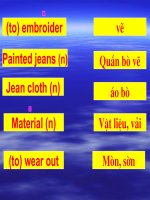Unit 4-The mass media
Bạn đang xem bản rút gọn của tài liệu. Xem và tải ngay bản đầy đủ của tài liệu tại đây (164.81 KB, 16 trang )
<span class='text_page_counter'>(1)</span><div class='page_container' data-page=1>
Date of preparation: October, 28th<sub> 2016</sub> <sub> Date of signing: October, 31</sub>st<sub> 2016</sub>
Distributive period: 31 Date of teaching:
Unit 4 The mass media
<b>Lesson 1</b>
<b>Getting started</b>
<b>A. Objectives: </b>
<b>1. Language focus</b>
To help Ss to know the overall topic of Unit 4: “<i>The mass media</i>”, some vocabulary related to <i>The </i>
<i>mass media</i>
- To check students’ comprehension thorough questions and answers
- To help learners get started with some language items in Unit 4
<b>2. Skills</b>
- To help learners get started with 4 skills in Unit 4.
- Reading: Reading for general ideas and specific information in an article about forms of mass media.
- Speaking: Talking about social networking.
- Listening: Listening for specific information in a conversation about social media: Language-learning
apps.
- Writing: Describing a pie chart showing the use of online resources.
<b>3. Attitudes</b>
- To help Ss get started for Unit 4 with the topic "<i> The mass media</i> "
- To provide Ss some motivation
<b>B. Preparations:</b>
- Teacher: Handouts, textbook, lesson plan, pieces of papers and cassette.
- Students: Textbook
<b>C. Methods: - The whole lesson: Integrated, mainly communicative.</b>
<b>D. Procedures:</b>
<b>Time/Stages</b> <b>Activities</b> <b>Interactions</b>
<b>1. Warm up</b>
<b> 5 minutes </b>
<b>1.</b> - T asks students to elicit some of their ideas of what a <i>green </i>
lifestyle is.
<b>2.</b> - T asks Ss to look at the picture and guess what the students in the
picture are talking about.
<b>3.</b> Sts answer.
T <--> Ss
<b>2. New </b>
<b>lesson</b>
<b>7 minutes</b>
<b>10 minutes</b>
<b>Activity 1: Nam and Lan are talking about the use of mobile </b>
<b>devices and the Internet. Listen and read</b>
- T. plays the recording, asks Ss to listen and read silently.
- Ss listen and read silently.
- T. tells Ss that they are going to listen to a conversation between
Nam and Lan talking about the mobile devices and the Internet to
access various form of the mass media.
<b>Activity 2: Answer the following questions </b>
- T. asks Ss to read the questions, and underline any key words before
they scan the conversation for the answers.
- Ss read the questions, underline any key words and scan the
conversation for the answers.
<b>Keys:</b>
1. They are chatting, sending messages or searching for news and
information on different websites.
2. Because everyone in his house uses digital devices to read the news.
3. He had used the computers in the local library to access the Internet.
4. She thinks that they may not understand the benefits of sharing online
information.
5. He thinks that she is addicted to social media and relies too much on
the Internet.
T <--> Ss
Whole class
Individually
</div>
<span class='text_page_counter'>(2)</span><div class='page_container' data-page=2>
<b>10 minutes</b>
<b>10 minutes</b>
6. Ss’ answers.
<b>Activity 3: Complete the table with the appropriate words</b>
<b>and phrases in the box</b>
- T. asks Ss to read the instructions and copy the names of the
groups on a piece of paper, has them work in pairs to go through
the conversation and find the relevant words and phrases, and copy
them into the correct column.
- Ss do as required by the T.
- Ss work in pairs to compare answers.
- T. checks answers as a class.
<b>Key:</b>
Digital devices: smartphones, tablet PCs, computers
The mass media: newspapers, magazines, radio, TV, DVDs, social
media, the Internet
Online activities: chatting, sending messages, searching for news
and information, reading online newspapers, accessing Internet
resources
<b>Activity 4: Read the text again. Pick out 5 verbs followed by </b>
<b>a prep. Discuss the meaning with a partner. </b>
- T explains to Ss how to do the activity.
- T has Ss scan the conversation quickly and underline the five
verb phrases in focus.
<b>Key</b> Cut down (on), subscribe to, take sth. with, listen to, connect
with
<b>Activity 5: Read the following sentence. Underline the verbs.</b>
<b>What tenses are they in?</b>
- T. reminds Ss of the verb forms of the tenses.
- T. has Ss underline the verbs forms in the two sentences.
- Ss underline the verbs forms in the two sentences.
- T. asks two Ss to explain which action happened first in each
sentence.
- Ss explain which action happened first in each sentence.
<b>Key</b>: He had (already) started using the computers in the local
library to access Internet resources
Past perfect (This action happened first)
When Minh’s dad bought him a tablet PC four months ago.
Past simple
Individually
or
Pair work
T <--> Ss
Individually
T <--> Ss
Individually
T <--> Ss
<b>3.</b>
<b>Consolidation</b>
<b>2 minutes</b>
- Ask Ss: What have you learnt today? What can you do now?
- Summarize the main points of the lesson. T <--> Ss
<b>4. Homework</b>
<b>1 minute</b> - Ask Ss to learn by heart the words or phrases related to the topic<sub>- Prepare for the next lesson.</sub> <sub>T <--> Ss</sub>
<b>E. Experience:</b>
...
...
...
Date of preparation: October, 28th<sub> 2016</sub> <sub> Date of signing: October, 31</sub>st<sub> 2016</sub>
Distributive period: 32 Date of teaching:
</div>
<span class='text_page_counter'>(3)</span><div class='page_container' data-page=3>
<b>A. Aims and Objectives: </b>
<b>1. Language focus</b>
- To provide learners some language items in Unit 4
- For vocabulary, that is words and phrases related to <i>The mass media</i>
- For pronunciation, that is the pronunciation of the verb ending -ed in connected speech
- For grammar, that is the prepositions after certain verbs and the past perfect vs. the past simple.
<b>2. Skills</b>
- To promote Ss to develop the skill of working in pairs and groups
<b>3. Attitudes</b>
- To encourage Ss to work harder
- To provide Ss some motivation
<b>B. Preparations:</b>
- Teacher: Handouts, textbook, pieces of papers, lesson plan and cassette.
- Students: Textbook
<b>C. Methods: - The whole lesson: Integrated, mainly communicative.</b>
<b>D. Procedures:</b>
<b>Time/Stages</b> <b>Activities</b> <b>Interactions</b>
<b>1. Homework</b>
<b> 3 minutes </b> - T spells some words, asking Ss to try to recognize them<sub>- Ss try to recognize them</sub>
- T. asks Ss to read the context provided to do the task.
- T can provide support by encouraging Ss to use the context and clues in
the conversation.
Media website communication smart phone
Email television newspaper magazine
T <--> Ss
<b>2. New lesson</b>
<b>5 minutes</b>
<b>7 minutes</b>
<b>12 minutes</b>
<b>A. Vocabulary:</b>
<b>Activity 1: Match the words and phrases with the definitions.</b>
- Ss work individually, read each word or phrase and match it with the
definitions.
<b>- </b>T checks answers as a class.
If necessary, ask a few Ss to say the equivalent meaning of these words
and phrase in Vietnamese.
<b>Key</b>: a. 3 b.1 c.5 d.2 e.6 f.4
<b>Activity 2: Complete the sentences with the correct forms of </b>
<b>the words and phrases in 1.</b>
1. - Sts do as required, bearing in mind a verb or a noun must be used its
suitable form (e,g. verb tense, singular or plural form of nouns).
- T asks Ss to complete the sentences individually. Alternatively, in a
weaker class, T has Ss work on the sentences in pairs.
- Sts find the suitable words to fill in the gaps.
- T checks answers as a class.
<b>Key:</b> 1. Mass media 2. Addicted
3. social networking 4. Efficient
5. instant messaging 6. Cyberbullying
<b>2. Pronunciation: </b>
<b>Revision: The pronunciation of the verb ending -ed</b>
<b>Activity 1. Listen and repeat, paying attention to the ending </b>
<b>-ed of the verbs</b>
- T tells Ss what the objective of the activities is, and asks them to read the
information in the Remember box.
- T plays the recording for Ss to listen and repeat all the verbs chorally.
- Ss recognise and practise the pronunciation of the verb ending-ed.
- Ss repeat chorally and individually.
<b>Activity 2: Listen and repeat the following sentences, paying </b>
<b>attention to the verbs ending -ed</b>
- T plays the recording for Ss to repeat chorally and individually.
- Ss listen and repeat the following sentences, paying attention to the
Individually
T <--> Ss
Individually
T <--> Ss
</div>
<span class='text_page_counter'>(4)</span><div class='page_container' data-page=4>
<b>15 minutes</b>
verbs ending -ed.
<b>2. Grammar: Prepositions after certain verbs</b>
<b>Activity 1: Match each verb with a preposition </b>
<i>The aim of this matching activity is to focus Ss’ attention on collocations </i>
<i>consisting of verbs and prepositions that normally appear together.</i>
- T has Ss work in pairs to read the Do you know..? box and discuss the
meaning of the verb phrases provided.
- T explains that these prepositions are called dependent prepositions and
the combination of a verb and one or two prepositions is a verb phrase (cf.
phrasal verb), which is used to express specific meaning.
- Ss work in pairs to discuss the meaning of the verb phrases provided and
do the matching.
<b>Key: </b>1. d 2. e 3. b 4. a/c 5.c
<b>Activity 2: Make sentences with the verbs in 1 </b>
The aim of this activity is to help Ss to use the verb phrase in 1 in context.
- T allows time for Ss to work individually
- T asks them to exchange their work in pairs for peer comments.
- T asks a few Ss to read their sentences aloud, and have the class make
comments on grammar, word choices and meaning.
- Ss make sentences with the verbs in 1.
<b>The past perfect vs. the past simple</b>
- T asks Ss if they can remember the use of relative pronouns who, that,
and which.
- Sts read the Do you know…? and explain the difference between which
defining something in the main clause and which defining the whole idea
of the main clause.
Main clause, which + relative clause
Note: <i>In relative clauses, the relative pronoun which can be used to </i>
<i>define the whole idea presented in the main clause. It is usually separated </i>
<i>with a comma after the main clause.</i>
<b>Activity 1: Put the verbs in brackets in the correct tenses.</b>
The aim of activities 1 and 2 is to revise the use of the past perfect and the
past simple, and help Ss to distinguish between the forms and usage of the
two tenses.
- T explains the objective of activity 1, and ask Ss to read the Remember
box. Check their comprehension and review the formation of the past
perfect (had + past participle).
- T allows time for Ss to do the task individually.
- Ss do as required
- T checks answer as a class, then invites a few Ss to read the sentences
aloud if necessary.
<b>Key: </b>1. had invented, completed<b> </b>2. appeared, helped
3. had risen, started 4. understood, had read
5. Had (ever) … appeared, took part, had
6. got, submitted, showed, had arrived 7. had already finished, left, arrived
<b>Activity 2: Complete the following sentences using either the </b>
<b>past simple or past perfect and your own ideas.</b>
<i>This activity enables Ss to use the target tenses in context. </i>
- T informs Ss of the objective of the activity.
- T asks Ss to work independently.
- T tells them to exchange their work with a partner for peer checking.
- T asks a few Ss to read out their sentences and have the rest of the class
comment on the use of the tenses, word choice, sentences structure and
meaning.
- Ss work independently to exchange their work with a partner for peer
checking.
- A few Ss read out their sentences and the rest of the class comment on
T <--> Ss
Pair work
T <--> Ss
Individually
Ss <--> Ss
T <--> Ss
Individually
Ss <--> Ss
</div>
<span class='text_page_counter'>(5)</span><div class='page_container' data-page=5>
the use of the tenses, word choice, sentences structure and meaning.
<b>Suggested answers:</b>
1. … had used the library’s computer to get access to the Internet.
2. … rang his doorbell.
3. … started sending me their greetings/ had already posted their greetings
for my birthday.
4. … they began drawing their charts.
5. … the teacher changed the topic.
6. … he wrote a brief description of the data.
T <--> Ss
<b>3.</b>
<b>Consolidation</b>
<b>2 minutes</b>
- Ask Ss: What have you learnt today? What can you do now?
- Summarize the main points of the lesson.
<b>Expected answers:</b>
<i>+ I can use: </i>ed-ending in connected speech
Prepositions after certain verbs
The past perfect and past simple
T <--> Ss
<b>4. Homework</b>
<b>1 minute</b> - T asks Ss to do exercises again at home.<sub>- Prepare for the next lesson.</sub>
- Complete Exercises in workbook.
T <--> Ss
<b>E. Experience:</b>
...
Date of preparation: November 5th <sub> Date of signing: November 7</sub>th
Distributive period: 33 Date of teaching:
Unit 4 The mass media
<b>Lesson 3</b>
<b>Reading</b>
<b>A. Aims and Objectives: </b>
- To teach Ss to scan a text for specific information in an article in an article about forms of mass
media.
- To teach Ss new vocabulary by completing true false task.
- To develop their reading skill through choosing the main idea for each paragraph.
- To learn new vocabulary by finding words or expressions with the definitions given.
<b>B. Preparations:</b>
- Teacher: Handouts, textbook, pieces of papers, lesson plan and cassette.
- Students: Textbook
<b>C. Methods: - The whole lesson: Integrated, mainly communicative.</b>
<b>D. Procedures:</b>
<b>Time/Stages</b> <b>Activities</b> <b>Interactions</b>
<b>1. Lead-in</b>
<b> 8 minutes </b>
T informs the class of the lesson objectives: skimming and scanning
an article for general ideas and specific information, and learning
additional vocabulary and information related to the history and
forms of mass media.
Ss work in pairs, look at the vocabulary items in the word bank and
discuss their meanings.
T <--> Ss
<b>2. New </b>
<b>lesson</b>
<b>17 minutes</b>
<b> Mass media forms </b>
<b>Activity 1: Put the words and phrases related to the mass </b>
<b>media in three groups</b>
- T asks Ss to work in pairs, has them look at the vocabulary items
in the word bank and discuss their meanings, encourages them to
</div>
<span class='text_page_counter'>(6)</span><div class='page_container' data-page=6>
<b>12 minutes</b>
<b>5 minutes</b>
use a dictionary if necessary.
- T checks the meanings of the vocabulary items as a class.
- T checks answers as a class.
<b>Key:</b>
Print: books, magazines, leaflets, newspapers
Television: news programmes, dramas, reality shows, documentaries
The Internet: email, websites, instant messaging, data sharing
<b>Activity 2: Quickly read instructions and choose the best </b>
<b>heading for the text. </b>
<i>This activity is reading for gist or general ideas. </i>
- T. gets Ss to read instructions and predict the best heading for the
text.
- T checks answer as a class, invites one or two Ss to explain how
they came up with their answers.
- T draws Ss’ attention to the keywords (… each form of…; new
digital media forms…) in the last paragraph.
- Ss read instructions and choose the best heading for the text.
<b>Key</b>: Forms of mass media
<b>Activity 3: Match each of the following words with its meaning.</b>
<i>This matching activity is to improve and expand Ss’ vocabulary by </i>
<i>learning words in context.</i>
- Ss do the task individually.
- T checks answers as a class, invites several Ss to say the
Vietnamese equivalent to help less able Ss to understand their
meanings better.
<b>Key:</b> a. 3 b. 4 c. 6 d. 2 e. 7 f. 1 g. 5
<b>Activity 4: True, False or Not given:</b>
<i>This activity focuses on reading for specific information.</i>
- Ss read the sentences in the table and underline the key words
which help to justify the answers.
- T checks answers as a class.
<b>Key</b> 1. F 2. T 3. F 4. F 5. T 6. NG 7. F
<b>Activity 5: Discussion</b>
<i>Discuss the forms of mass media that you use daily. Explain how </i>
<i>you benefit from using them.</i>
The aim of this activity is to relate the information in the article in 2
to Ss’ own experiences of using the different forms of mass media
for personal communication or finding useful information.
- T asks Ss to work in pairs to share their preferred forms of mass
media for daily communication or finding information, and how
they benefit from using them.
- T reminds them of the six forms of mass media mentioned in the
text: print, recordings, cinema, radio, television and the Internet.
- T asks several pairs to report their discussion results to the class.
- Ss work in groups of four to discuss the forms of mass media that
are used daily.
T <--> Ss
Pair work
T <--> Ss
Pair work
T <--> Ss
Individually/
Pair work
T <--> Ss
Group work
T <--> Ss
<b>3.</b>
<b>Consolidation</b>
<b>2 minutes</b> - Summarize the main points of the lesson T <--> Ss
<b>4. Homework</b>
</div>
<span class='text_page_counter'>(7)</span><div class='page_container' data-page=7>
...
...
...
Date of preparation: November 12th <sub> Date of signing: November 14</sub>th
Distributive period: 34 Date of teaching:
Unit 4 The mass media
<b>Lesson 4</b>
<b>Speaking</b>
<b>A. Aims and Objectives:</b>
<b> - To teach Ss to talk about </b>social networking.
- To teach Ss to practise sharing and giving responses to new information.
<b> - By the end of the lesson, students will be able to: </b>
+ Express their opinion about social networking
+ Perform their viewpoints to other people in real life.
<b>B. Preparations:</b>
- Teacher: Handouts, textbook, lesson plan and pieces of papers.
- Students: Textbook
<b>C. Methods: - The whole lesson: Integrated, mainly communicative.</b>
<b>D. Procedures:</b>
<b>Time/Stages</b> <b>Activities</b> <b>Interactions</b>
<b>1. Warm up</b>
<b> 8 minutes </b>
- Ss work in groups to make a list of their favourite social
networking sites
Making as many words as possible from the words :
A SOCIAL NETWORKING SITE.
- Social networking sites: Facebook, Twitter, Linkedln, Pinterest,
Google Plus +, Instagram, etc. (The following URL is a good
reference for the most popular social networking sites:
T <--> Ss
<b>2. New </b>
<b>lesson</b>
<b>10 minutes</b>
<b>11 minutes</b>
<b>Talking about social networking</b>
<b>Activity 1: Complete the conversation with the sentences in </b>
<b>the box</b>
- T asks Ss to read the sentences in the box and the conversation,
reminds them to underline any contextual clues in the sentences
that may help them to work out the answers. These clues can
include synonyms, definitions, comparisons, etc.
- Ss read the sentences in the box and the conversation and then
do the task as required.
- T checks answers as a class.
<b>Key: </b>1. E 2. C 3. D 4. B 5. F 6. A
Individually
</div>
<span class='text_page_counter'>(8)</span><div class='page_container' data-page=8>
<b>13 minutes</b>
<b>Activity 2: Put the following opinions about using social </b>
<b>networks in the appropriate box</b>
- T lets Ss work in pairs to complete the conversation.
- Encourage Ss to share their ideas and help each other complete
the sentences.
<b>Key:</b>
Positive opinions: 2, 4, 5
Negative opinions: 1, 3, 6
<b>Activity 3: Make a similar conversation </b>
- T explains the opinions provided in the table.
- T asks Ss to work in pairs: One gives either the positive or negative
opinions and the other expresses the opposite opinions, encourages Ss to
add more ideas of their own.
- T asks several pairs to role-play their conversations in front of the
class, encourages Ss to make comments or ask questions.
- Ss make a similar conversation (as in 3) and express the opinions
about social networking. Ss explain the opinions provided in the table.
Pair work
T <--> Ss
Pair work
Ss <--> Ss
<b>3.</b>
<b>Consolidation</b>
<b>2 minutes</b>
- Summarize what they have learnt by asking Ss some questions:
What have you learnt today? What can you do now? T <--> Ss
<b>4.Homework</b>
<b>1 minute</b> - Ask students to learn by heart the expressions.<sub>- Prepare for the next lesson.</sub> <sub>T <--> Ss</sub>
<b>E. Experience:</b>
...
...
...
Date of preparation: November 12th <sub> Date of signing: November 14</sub>th
Distributive period: 35 Date of signing:
Unit 4 The mass media
<b>Lesson 5</b>
<b>Listening</b>
<b>A. Aims and Objectives: </b>
- To develop Ss’ skill of listening to for general ideas and specific information in a conversation
about social media: language-learning apps
- To help Ss understand general ideas and specific details to answer comprehension questions.
- By the end of the lesson, students will be able to:
+ Listen and do the tasks.
+ Develop the listening skills for specific details.
+ Identify specific information through multiple-choice task and question answering
<b>B. Preparations:</b>
- Teacher: Handouts, textbook, pieces of papers and cassette.
- Students: Textbook
<b>C. Methods: - The whole lesson: Integrated, mainly communicative.</b>
<b>D. Procedures:</b>
<b>Time/Stages</b> <b>Activities</b> <b>Interactions</b>
<b>1. Lead-in</b>
<b> 7 minutes </b>
- Inform the class of the lesson objectives: listening for specific
information in a conversation between two students talking about
their uses of social media and how they use it for language
learning. T <--> Ss
<b>2. New </b>
</div>
<span class='text_page_counter'>(9)</span><div class='page_container' data-page=9>
<b>10 minutes</b>
<b>13 minutes</b>
<b>12 minutes</b>
<b>Complete the sentences with the words from the box.</b>
<i>- The aim of this gap-filling activity is to provide some language/ </i>
<i>vocabulary input and information that Ss will need in order to </i>
<i>understand and complete the listening activities that follow. Check</i>
<i>Ss’ comprehension of the words in the word bank. Explain </i>
<i>unfamiliar words or ask Ss to look them up in a dictionary.</i>
- T allows time for Ss to quickly read the conversation and
complete the gapped sentences.
- T checks answers as a class.
<b>Key: </b>1. app 2. record 3. GPS
4. interactive 5. connect 6. audio 7. updates
<b>Task 2: Listen to a conversation between two students </b>
<b>talking about language learning applications. Which of the </b>
<b>following did they not talk about?</b>
<i>This activity focuses on listening for specific information. Explain </i>
<i>the objective of the activity.</i>
- T asks Ss to read the instructions and the information provided,
draws their attention to what was not mentioned in the
conversation.
- T plays the recording without pausing, so Ss can get the gist of it.
- T plays the recording again. This time T asks Ss to listen and
circle the information that they did not hear in the recording.
<b>Key</b> : 2 & 3
<b>Task 3: Listen again. Give short answers to the following </b>
<b>questions. </b>
- T asks Ss to read through the questions and answer them.
- T plays the recording again for Ss to check their answer. For less
able Ss, pause the recording after the sentences that include the
information/ answer to the question. T encourages them to note
down the answer.
- T asks Ss to exchange their answer with a partner for peer
review. Ss listen to the recording. Ss do as required, then share
their ideas so that they can help each other with the answers.
1. - Ss do as required.
<b>Key:</b>
1. He showed her a few social networking sites that help people to
improve their English.
2. She downloaded some language learning apps on her
smartphone and started learning vocabulary on the go.
3. Because she wants to improve her English.
4. She uses some social networking sites.
5. She used a free programme on her smartphone.
6. She used it to collect samples from English TV and radio.
Pair work
T <--> Ss
Group work
T <--> Ss
Individually
T <--> Ss
<b>3.</b>
<b>Consolidation</b>
<b>2 minutes</b>
- Ask Ss to consolidate the main contents.
- Ask Ss: <i>What have you learnt today? </i>
<i> What can you do now?</i> T <--> Ss
<b>4. </b>
<b>Homework</b>
<b>1 minute</b> - Prepare for the next lesson. T <--> Ss
</div>
<span class='text_page_counter'>(10)</span><div class='page_container' data-page=10>
...
...
...
Date of preparation: November 19th <sub> Date of signing: November 21</sub>st
Distributive period: 36 Date of signing:
Unit 4 The mass media
<b>Lesson 6</b>
<b>Writing</b>
<b>A. Aims and Objectives: </b>
- To develop Ss’ skill of describing a pie chart showing the use of online resources.
- To provide Ss with the language and sentence structures used to describe trends.
- By the end of the lesson, students will be able to:
+ Learn about a pie chart showing the use of online resources.
+ Describe a pie chart showing the use of online resources.
+ Develop the writing skills in general. Build up vocabulary supported for writing.
<b>B. Preparations:</b>
- Teacher: Handouts, textbook, lesson plan and pieces of papers.
- Students: Textbook
<b>C. Methods: - The whole lesson: Integrated, mainly communicative.</b>
<b>D. Procedures:</b>
<b>Time/Stages</b> <b>Activities</b> <b>Interactions</b>
<b>1. Check up</b>
<b> 5 minutes The lesson objective: describing a pie chart showing Ss’ use of </b>
online resources at a secondary school. T <--> Ss
<b>2. New </b>
<b>lesson</b>
<b>15 minutes</b>
<b>8 minutes</b>
<b> Describing a pie chart showing the use of online resources</b>
<b>Task 1: In pairs, discuss what a pie chart is and how you </b>
<b>can describe it. </b>
- T asks Ss to look at the illustrations in this section and credit
their answers.
- Sts do as required.
+ A pie chart is a circular chart divided into triangular areas
(slices/ segments) proportional to the percentages of the whole.
+ To describe a pie chart we should specify the information
(content) and proportion of each segment, which can be measured
in percentages (%) or fraction (e.g. one-third, a quarter).
<b>Task 2: The pie chart below illustrates the forms of </b>
<b>communication used by students in Intel school. Complete </b>
<b>the description with the words in the box. </b>
- T asks Ss to read the words in the box and check their
comprehension, explains unfamiliar words, e.g. tie in (to link
something or to be linked with something), dominant (more
noticeable), majority (the largest part of a group of things).
- T allows time for Ss to read the text and do the task, monitors Ss’
progress and offer help it necessary.
- T checks answer as a class.
<b>Key:</b>
Pair work
T <--> Ss
</div>
<span class='text_page_counter'>(11)</span><div class='page_container' data-page=11>
1. preferences 2. recorded 3. majority
4. tied in 5. dominant 6. the least
<b>Task 3: Study the pie chart and write a paragraph of about</b>
<b>130-160 words to describe the sections.</b>
This activity aims to provide an opportunity for Ss to describe a
pie chart.
- T asks Ss to work in pairs and read the related information,
checks their comprehension and give explanations if necessary.
- T asks Ss to work in pairs and discuss the words and phrases in
the Do you know...? box.
- T has them write their drafts independently, following the sample
in 2, and make use of the language in the Do you know…? Box.
Ask Ss to exchange their drafts with a partner for peer review.
- Sts work independently and write their final drafts.
- One or two students write the description on the board.
- T collects some drafts and give comments or ask the rest of the
class to provide feedback, encourages Ss to make revisions and
based on the feedback.
- Ss listen to the T’ feedback
<b>Suggested answer:</b>
The pie chart shows students’ preferred online resources recorded
in a survey carried out at Intel Secondary School Library in 2014.
A brief description of the students’ preferences follows.
We can see that a majority of students used interactive games,
which rank the first at 30%. Fiction e-books line in the second at
20%, and are given 10% less than interactive games. Online
magazines rank the third at 18% while non-fiction e-books account
for 15%. Online dictionaries are the fifth library resource at 11%.
Only a minority of students, or 6% used science journals, which is
the least popular of all resources, and used five old less than the
most preferred resource, interactive games.
To conclude, the dominant form of online resources used by the
students at Intel Secondary School Library is interactive games. Of
all the resources – fiction e-books, online magazines, non-fiction
e-books, online dictionaries – students used science journals the
least.
T <--> Ss
<b>3.</b>
<b>Consolidation</b>
<b>2 minutes</b>
- Ask Ss to consolidate the main contents.
- Ask Ss to complete the writing at home and collect
- Ask Ss: <i>What have you learnt today? </i>
<i> What can you do now?</i>
T <--> Ss
<b>4.Homework</b>
<b>1 minute</b> - Write the text again at home.<sub>- Prepare for the next lesson.</sub> <sub>T <--> Ss</sub>
<b>E. Experience:</b>
</div>
<span class='text_page_counter'>(12)</span><div class='page_container' data-page=12>
Date of preparation: November 19th <sub> Date of signing: November 21</sub>st
Distributive period: 37 Date of signing:
Unit 4 The mass media
<b> </b>
<b>Lesson 7</b>
<b> Communication and culture</b>
<b>A. Aims and Objectives: </b>
<b>1. Language focus</b>
- To provide learners some communication samples and cultural items
<b> 2. Skills</b>
- To promote Ss to develop their communication skills and cultural understanding
- To help Ss develop the skill of working in pairs and groups
<b> 3. Attitudes</b>
- To encourage Ss to work harder
- To provide Ss some motivation
- By the end of the lesson, students will be able to:
+ Understand and communicate about communication skills and cultural understanding
<b>B. Preparations:</b>
- Teacher: Handouts, textbook, lesson plan and pieces of papers.
- Students: Textbook
<b>C. Methods: - The whole lesson: Integrated, mainly communicative.</b>
<b>D. Procedures:</b>
<b>Time/Stages</b> <b>Activities</b> <b>Interactions</b>
<b>1. Warm up</b>
<b> 5 minutes </b> - Inform the class of the lesson objectives: Further skill <sub>development</sub> <sub>T <--> Ss</sub>
<b>2. New </b>
<b>lesson</b>
<b>18 minutes</b>
<b>19 minutes</b>
<b>1. Communication</b>:
<b>Learning English with video</b>
<b> Activity 1: Listen to a conversation between Nam and Mai </b>
<b>about learning English with video. Decide whether the </b>
<b>statements are T or F. </b>
- T asks Ss to read the instructions and the information provided,
has them underline the key words and any other clues in the
statements and explain their decision, checks Ss’ comprehension
and give feedback.
- T plays the recording all the way through for the first time, plays
it again for Ss to do the task. If Ss are not sure of more than two
answers, T plays the recording a third time for Ss to check again.
- Ss work in pairs to compare their answer.
<b>Key</b>: 1. F 2. T 3. T 4. F 5. T
<b>Activity 2:Discussion</b>
- T asks Ss to work in groups and discuss what videos they would
like to watch in their English lessons classes.
- T invites one or two groups to present their ideas in front of the
class
<i><b>Suggested ideas:</b></i>
1. The videos clips are powerful audio-visual resources for
learning a language.
2. They can: - provide authentic language use
- capture learners’ attention
- increase their motivation
Pair work
T <--> Ss
Group work
</div>
<span class='text_page_counter'>(13)</span><div class='page_container' data-page=13>
- enhance their learning experience
<b>2. Culture: Social media apps</b>
<b>Activity 1: Read the following text and give short answers to</b>
<b>the questions. </b>
- T asks Ss to read the questions and underline the key works or
any clues that may help them to identify the answers as they scan
the text.
- Ss read the instructions and brainstorm the social networking
sites that they consider as the most popular
- Ss compare their answers with a partner.
<b>Key:</b>
1. They are for communication, entertainment and security on the
Internet.
2. Because they want to have more advanced options than basic
services.
3. A video-sharing app is an application for creating videos and
sharing them with family and friends.
4. They are action and adventure games followed by puzzles and
board games.
5. Beside protecting smartphones and tablet devices from theft and
loss of data, these security apps detect and remove viruses as well
as phishing scams.
6. We should go through its functions very carefully and read the
user reviews.
<b>Activity 2: Work in groups. Tell your group about your </b>
<b>favorite social networking app and its functions.</b>
- Ss discuss their favourite social networking apps in groups.
- Ss read the questions and underline the key works or any clues
that may help them to identify the answers as they scan the text.
- Some Ss are asked to present the apps and demonstrate its
functions in front of the class.
Pair work
T <--> Ss
Group work
T <--> Ss
<b>3.</b>
<b>Consolidation</b>
<b>2 minutes</b>
- Ask Ss to consolidate the main contents.
- Ask Ss: <i>What have you learnt today? </i>
<i> What can you do now?</i>
- Elicit answer: I have improved my listening, speaking and
reading skills. I can talk about the educational values of videos for
learning English. I can also talk about social media apps for
communication, entertainment and security.
T <--> Ss
<b>4.Homework</b>
<b>1 minute</b> - T asks Ss to learn the structures and vocabulary.<sub>- Prepare for the next lesson.</sub> <sub>T <--> Ss</sub>
<b>E. Experience:</b>
</div>
<span class='text_page_counter'>(14)</span><div class='page_container' data-page=14>
Date of preparation: November 19th <sub> Date of signing: November 21</sub>st
Distributive period: 38 Date of signing:
Unit 4 The mass media
<b> </b>
<b>Lesson 8</b>
<b> Looking back and project</b>
<b>A. Aims and Objectives: </b>
- To help Ss pronounce revise what they have learned in unit 4.
- To teach Ss some lexical items related to the social media apps.
- To give them a chance to do a small project in which they can develop their speaking skills
- To help Ss review and recognize the pronunciation of ed in connected speech.
- To help Ss consolidate the use of simple past tense and past perfect tense.
- To provide further opportunities for Ss to use the language, skills and information they have learnt
in the unit 4.
- By the end of the lesson Ss are able to:
+ Use some key words of the social media apps.
+ Do the exercises on simple past tense and past perfect tense
<b>B. Preparations:</b>
- Teacher: Handouts, textbook, pieces of papers, lesson plan and cassette.
- Students: Textbook
<b>C. Methods: - The whole lesson: Integrated, mainly communicative.</b>
<b>D. Procedures:</b>
<b>Time/Stages</b> <b>Activities</b> <b>Interactions</b>
<b>1. Warm-up</b>
<b> 5 minutes </b>
<b>-</b>T informs the class the objectives: reviewing pronunciation,
vocabulary and grammar.
- T reviews from and use of simple past tense and past perfect
tense.
T <--> Ss
<b>2. New </b>
<b>lesson</b>
<b>10 minutes</b>
<b>7 minutes</b>
<b>Pronunciation:</b>
<b>Activity 1: Put the words in the correct box. </b>
- T asks Ss to do the task independently, has them exchange their
answers with a partner for peer review.
- Ss put the words in the correct box, then compare their answers
in pairs or groups
<b>Key:</b>
/t/: watched, surfed, talked, checked
/d/: installed, enabled, shared, enjoyed, offered
/id/: updated, reported, provided, protected, downloaded
<b>Activity 2Listen and write down the verbs in the appropriate</b>
<b>columns. </b>
- T plays the recording, has Ss listen and write down the verbs in
the appropriate columns.
- Ss compare their answers in pairs
- Ss are asked to read the verbs aloud.
<b>Key</b>
1. decreased 2. developed 3. downloaded
4. influenced 5. invented 6. emerged
7. produced 8. provided 9. compared
/t/: 1. decreased 2. developed 4. influenced 7. produced
/d/: 6. emerged 9. compared
/id/: 3. downloaded 5. invented 8. provided
<b>Vocabulary:</b>
<b>Activity 1: Complete the sentences with the correct words / </b>
<b>phrases in the box.</b>
The aim of the activity is to review the key vocabulary related to
Individually
T <--> Ss
Pair work
</div>
<span class='text_page_counter'>(15)</span><div class='page_container' data-page=15>
<b>12 minutes</b>
<b>8 minutes</b>
the topic
T asks Ss to underline the key words in each sentence, then fill in
the gaps with the words given, making changes if necessary
- Ss compare their answers in pairs or groups.
- T gives feedback.
<b>Key:</b>
1. disposal of 2. depleted 3. cluster 4. organic
5. combustion 6. soot particles 7. pathway
<b>Activity 2: Complete the gapped sentences with the words </b>
<b>in the box</b>.
- T asks Ss to read and complete the gapped sentences.
- Ss are asked to underline the key words in each sentence, then fill
in the gaps with the words given.
<b>Key:</b>
1. social media 2. Social networking 3. Mass media
4. app 5. Advent 6. Microblogging
<b>Grammar:</b>
<b>Activity 1: Complete the gapped sentences with the </b>
<b>appropriate prepositions. </b>
- T asks Ss to read the statements and understand all the verbs and
the words after the blanks.
- Ss discuss these clues in pairs and decide on the correct
preposition.
<b>Key</b>: 1. on 2. Out 3. to 4. for 5. of/ about 6. with
<b>Activity 2: Match the two halves of the sentences.</b>
- T asks Ss to read and complete the gapped sentences.
- Ss are asked to underline the key words in each sentence, then
match the sentences.
<b>Key:</b> 1.b 2.d 3.a 4.e 5.f 6.c
<b>Activity 3: Put the words in brackets in past simple or past </b>
<b>perfect tense. </b>
- T asks Ss to read the incomplete sentences and underline any key
words independently.
- Ss underline the key words in each sentence and decide which
two halves can make a meaningful sentence.
- Ss exchange the answers in pairs.
<b>Key:</b>
1 had had 2. attended 3. deleted, had received
4. got, stopped 5. had wasted 6. had edited, uploaded
<b>Project:</b>
<b>Interview three classmates to find out their opinions about </b>
<b>social networking sites and apps. Then report to the class. </b>
Ask Ss to work in groups of four.
Ask Ss to read and discuss the guiding questions.
T. encourages groups to prepare an outline for their presentation.
Pair work
T <--> Ss
Pair work
T <--> Ss
Individually
T <--> Ss
Group work
<b>3.</b>
<b>Consolidation</b>
<b>2 minutes</b>
- Ask Ss to consolidate the main contents.
- Ask Ss: <i>What have you learnt today? </i>
<i> What can you do now?</i>
</div>
<span class='text_page_counter'>(16)</span><div class='page_container' data-page=16>
<b>1 minute</b> <sub>- Prepare for the next lesson.</sub> <sub>T <--> Ss</sub>
<b>E. Experience:</b>
</div>
<!--links-->
Unit 7 :The mass media
- 7
- 804
- 6








